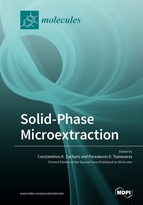Solid-Phase Microextraction
A special issue of Molecules (ISSN 1420-3049). This special issue belongs to the section "Analytical Chemistry".
Deadline for manuscript submissions: closed (31 January 2019) | Viewed by 72690
Special Issue Editors
Interests: pharmaceutical analytical chemistry; method development and validation; sample preparation (derivatization, microextraction, etc.); liquid and gas chromatography; capillary electrophoresis; mass spectrometry
Special Issues, Collections and Topics in MDPI journals
Interests: automation; sequential injection analysis; separation techniques (HPLC, CE); post-column derivatization; microextraction
Special Issues, Collections and Topics in MDPI journals
Special Issue Information
Dear Colleagues,
Almost twenty-five years after its introduction, fiber solid phase microextraction (SPME) is undoubtedly a mature sample preparation technique, with numerous applications in various scientific fields. Due to its versatility, reliability, low cost, and sampling convenience (on-site sampling), SPME has been widely used in combination with separation techniques (LC, GC, CE) in academic research and routine analysis as well. As a result of its impact, it has been introduced in several official methods. On-going research and new trends on SPME covers various aspects including, but not limited to, the manufacturing of new fiber coating materials, new designs (in-needle, in-tube, in-tube, etc.), incorporation of SPME in automated systems, etc.
The present Special Issue aims to cover the latest research trends and applications on to SPME. Researchers working on, but not limited, fiber coating technology, on-line automated SPME and their applications in food, enviromental and biomedical sciences are cordially invited to contribute a research or review article in this Special Issue.
Dr. Constantinos K. Zacharis
Dr. Paraskevas D. Tzanavaras
Guest Editors
Manuscript Submission Information
Manuscripts should be submitted online at www.mdpi.com by registering and logging in to this website. Once you are registered, click here to go to the submission form. Manuscripts can be submitted until the deadline. All submissions that pass pre-check are peer-reviewed. Accepted papers will be published continuously in the journal (as soon as accepted) and will be listed together on the special issue website. Research articles, review articles as well as short communications are invited. For planned papers, a title and short abstract (about 100 words) can be sent to the Editorial Office for announcement on this website.
Submitted manuscripts should not have been published previously, nor be under consideration for publication elsewhere (except conference proceedings papers). All manuscripts are thoroughly refereed through a single-blind peer-review process. A guide for authors and other relevant information for submission of manuscripts is available on the Instructions for Authors page. Molecules is an international peer-reviewed open access semimonthly journal published by MDPI.
Please visit the Instructions for Authors page before submitting a manuscript. The Article Processing Charge (APC) for publication in this open access journal is 2700 CHF (Swiss Francs). Submitted papers should be well formatted and use good English. Authors may use MDPI's English editing service prior to publication or during author revisions.
Keywords
- solid phase microextraction
- headspace solid phase microextraction
- on-fiber derivatization
- on-site sampling
- in-needle SPME
- in-tube SPME
- multiple extraction
- automation
- SPME coupling to various analytical systems-Instrumentation








